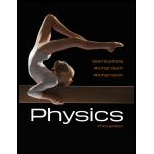
(a)
The possible values of charges.
(a)
Answer to Problem 86P
The charge of Sun can be
Explanation of Solution
Write an expression for equilibrium condition for gravitational and electrical force.
Here,
Rewrite equation (I).
Consider,
Rewrite equation (III) to find
Rewrite equation (II) to find
Substitute equation (IV) in equation (V).
Rewrite equation (VI) to find
Rewrite equation (III) to find
Rewrite equation (II) to find
Substitute equation (VIII) in equation (IX).
Rewrite equation (X) to find
Conclusion:
Substitute
Substitute
Thus, the charge of Sun can be
(b)
If charge imbalance explain Earth’s orbit.
(b)
Answer to Problem 86P
No, the charge imbalance explain Earth’s orbit.
Explanation of Solution
Consider the charge of electron and proton is different. The net charges on astronomical bodies are the sum of charge of the particles. If the magnitude of the charges of the proton and electron were not exactly equal, astronomical bodies will have a total charge with the same sign.
Like charges will repel each other. Since the charges of the astronomical bodies are similar, the force between them would be repulsive. The force responsible for the Earth’s orbit is attractive. Thus, the charge imbalance explain Earth’s orbit.
Want to see more full solutions like this?
Chapter 16 Solutions
Student Solutions Manual for Physics
 College PhysicsPhysicsISBN:9781305952300Author:Raymond A. Serway, Chris VuillePublisher:Cengage Learning
College PhysicsPhysicsISBN:9781305952300Author:Raymond A. Serway, Chris VuillePublisher:Cengage Learning University Physics (14th Edition)PhysicsISBN:9780133969290Author:Hugh D. Young, Roger A. FreedmanPublisher:PEARSON
University Physics (14th Edition)PhysicsISBN:9780133969290Author:Hugh D. Young, Roger A. FreedmanPublisher:PEARSON Introduction To Quantum MechanicsPhysicsISBN:9781107189638Author:Griffiths, David J., Schroeter, Darrell F.Publisher:Cambridge University Press
Introduction To Quantum MechanicsPhysicsISBN:9781107189638Author:Griffiths, David J., Schroeter, Darrell F.Publisher:Cambridge University Press Physics for Scientists and EngineersPhysicsISBN:9781337553278Author:Raymond A. Serway, John W. JewettPublisher:Cengage Learning
Physics for Scientists and EngineersPhysicsISBN:9781337553278Author:Raymond A. Serway, John W. JewettPublisher:Cengage Learning Lecture- Tutorials for Introductory AstronomyPhysicsISBN:9780321820464Author:Edward E. Prather, Tim P. Slater, Jeff P. Adams, Gina BrissendenPublisher:Addison-Wesley
Lecture- Tutorials for Introductory AstronomyPhysicsISBN:9780321820464Author:Edward E. Prather, Tim P. Slater, Jeff P. Adams, Gina BrissendenPublisher:Addison-Wesley College Physics: A Strategic Approach (4th Editio...PhysicsISBN:9780134609034Author:Randall D. Knight (Professor Emeritus), Brian Jones, Stuart FieldPublisher:PEARSON
College Physics: A Strategic Approach (4th Editio...PhysicsISBN:9780134609034Author:Randall D. Knight (Professor Emeritus), Brian Jones, Stuart FieldPublisher:PEARSON





